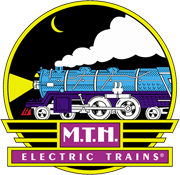Available Items

May 19, 2010 - By the late 1940s, the engines on the Milwaukee Road’s electrified Rocky Mountain Division were nearly three decades old and tired, and diesels were the wave of the future. Management was intending to pull down the overhead wires and dieselize the entire division. Then along came a big electric named Little Joe, and the wires stayed up for another quarter-century. Click on the video icon to the left to see the engine in action.
The Joes were actually built for another customer half a world away, Russia’s Trans-Siberian Railroad. But by the time they were ready to deliver in 1948, the Cold War had frozen sales to the Soviet Union, and builder General Electric was stuck with twenty 5,500 hp locomotives designed to run on 3,300 volts DC — most built to Russian 5’ track gauge. As the Milwaukee Road was one of the few American railroads with overhead DC power (at 3,000 volts), GE offered the entire order, including spare parts, to the Milwaukee at the fire sale price of one million dollars. At least one unit, painted in GE demo colors, was tested on both of the road’s electrified divisions in 1948 and acquired the nickname “Little Joe” after Joe Stalin.
But the Milwaukee came up with reasons not to make the purchase, and in 1949 three units went to the Chicago, South Shore and South Bend Railroad for freight service. They lasted until 1983, earning the honor of last electric engines in US mainline common-carrier freight service. Brazil’s Paulista Railroad bought five more Joes, nicknamed them Russas and operated them until 1999.
An upsurge of traffic from the Korean War convinced the Milwaukee it had made a mistake, and in August 1950 it purchased the remaining 12 Joes, without spare parts, for the original million-dollar price. All went to the Rocky Mountain Division between Harlowton, Montana and Avery, Idaho — ten designated EF-4 for freight service and two as EP-4s for Olympian Hiawatha passenger trains. Engineers loved the new Joes because they were more reliable than the road’s ancient boxcabs and much less stressful to operate.
Originally the freight units worked in pairs, with a boxcab helper added on the division’s tougher grades. But later in the 1950s a GP9 was attached to the Little Joe pairs and controlled from the lead Joe; this combination could run straight through electrified territory without adding or dropping helpers. By the following decade, Joes were simply cut in ahead of the freight diesels at the beginning of electrified territory, with the Joe’s engineer controlling all units. Eventually, however, second-generation diesels brought an end to electrification, and on June 15, 1974, the last Little Joes folded their pantographs — ending 58 years, 6 months, and 16 days of Milwaukee main line electrification. While most of the Joes were scrapped, three survive today: one Milwaukee Road unit in Deer Lodge, Montana, and South Shore units at the Illinois Railway Museum in Union, Illinois and the Lake Shore Railway Historical Museum in North East, PA, just ten miles from the GE plant where it was built.
New for 2010, the M.T.H. Little Joe duplicates the brute strength and dependability of the original, complete with a detailed die-cast metal body and, for the first time in HO, operating pantographs that raise and lower automatically according to the direction of travel.
WHERE TO BUY
The Little Joe can be ordered through any M.T.H. Authorized Retailer.






